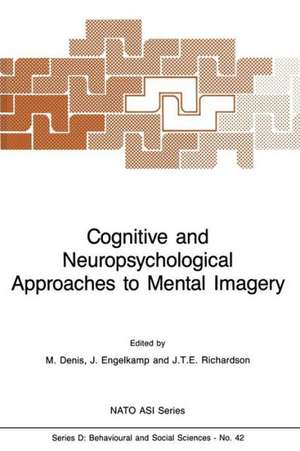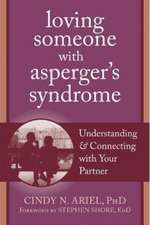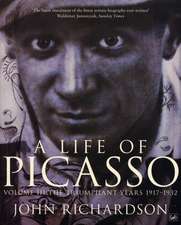Cognitive and Neuropsychological Approaches to Mental Imagery: NATO Science Series D:, cartea 42
Editat de M. Denis, Johannes Engelkamp, John T.E. Richardsonen Limba Engleză Paperback – 15 sep 2011
Din seria NATO Science Series D:
- 18%
 Preț: 1223.25 lei
Preț: 1223.25 lei -
 Preț: 399.88 lei
Preț: 399.88 lei -
 Preț: 398.74 lei
Preț: 398.74 lei - 18%
 Preț: 953.35 lei
Preț: 953.35 lei -
 Preț: 389.88 lei
Preț: 389.88 lei - 18%
 Preț: 1230.53 lei
Preț: 1230.53 lei -
 Preț: 399.29 lei
Preț: 399.29 lei - 18%
 Preț: 953.35 lei
Preț: 953.35 lei - 18%
 Preț: 1226.90 lei
Preț: 1226.90 lei - 5%
 Preț: 390.13 lei
Preț: 390.13 lei - 5%
 Preț: 370.94 lei
Preț: 370.94 lei -
 Preț: 412.95 lei
Preț: 412.95 lei - 18%
 Preț: 1224.18 lei
Preț: 1224.18 lei - 15%
 Preț: 480.20 lei
Preț: 480.20 lei -
 Preț: 412.95 lei
Preț: 412.95 lei - 18%
 Preț: 1226.73 lei
Preț: 1226.73 lei - 5%
 Preț: 2124.15 lei
Preț: 2124.15 lei - 15%
 Preț: 638.11 lei
Preț: 638.11 lei - 18%
 Preț: 1833.16 lei
Preț: 1833.16 lei -
 Preț: 401.24 lei
Preț: 401.24 lei -
 Preț: 390.84 lei
Preț: 390.84 lei - 18%
 Preț: 1237.80 lei
Preț: 1237.80 lei - 18%
 Preț: 1826.69 lei
Preț: 1826.69 lei - 18%
 Preț: 1830.34 lei
Preț: 1830.34 lei -
 Preț: 388.13 lei
Preț: 388.13 lei - 18%
 Preț: 948.47 lei
Preț: 948.47 lei - 18%
 Preț: 1835.53 lei
Preț: 1835.53 lei - 18%
 Preț: 1227.67 lei
Preț: 1227.67 lei - 18%
 Preț: 1225.79 lei
Preț: 1225.79 lei -
 Preț: 398.53 lei
Preț: 398.53 lei - 18%
 Preț: 1831.73 lei
Preț: 1831.73 lei -
 Preț: 396.24 lei
Preț: 396.24 lei - 18%
 Preț: 1661.13 lei
Preț: 1661.13 lei
Preț: 376.95 lei
Preț vechi: 396.78 lei
-5% Nou
Puncte Express: 565
Preț estimativ în valută:
72.14€ • 75.04$ • 59.55£
72.14€ • 75.04$ • 59.55£
Carte tipărită la comandă
Livrare economică 15-29 aprilie
Preluare comenzi: 021 569.72.76
Specificații
ISBN-13: 9789401071215
ISBN-10: 9401071217
Pagini: 448
Ilustrații: 443 p.
Dimensiuni: 155 x 235 x 24 mm
Greutate: 0.62 kg
Ediția:Softcover reprint of the original 1st ed. 1988
Editura: SPRINGER NETHERLANDS
Colecția Springer
Seria NATO Science Series D:
Locul publicării:Dordrecht, Netherlands
ISBN-10: 9401071217
Pagini: 448
Ilustrații: 443 p.
Dimensiuni: 155 x 235 x 24 mm
Greutate: 0.62 kg
Ediția:Softcover reprint of the original 1st ed. 1988
Editura: SPRINGER NETHERLANDS
Colecția Springer
Seria NATO Science Series D:
Locul publicării:Dordrecht, Netherlands
Public țintă
ResearchCuprins
1 Key Issues in Imagery Research.- Basic puzzles in imagery research.- A computational theory of the mental imagery medium.- 2 Imaginal Coding and the Processing of Verbal Information.- 2.1. Imagery and the Representation of Visual Information.- Reading mental images.- Mental imagery and perception: Modularity or functional equivalence ?.- Imagery and memory.- 2.2. The Processing of Lexical Information.- Stroop and priming effects in naming and categorizing tasks using words and pictures.- Alternative coding of concepts.- Images, predicates, and retrieval cues.- The importance of age of word acquisition for imageability in word processing.- Frequency, imagery value and types of features in natural categories.- 2.3. Sentence and Text Processing.- Imagery and prose processing.- Imagery and integrative processing.- Metamemory-memory connections and their development under imaginal encoding conditions.- 2.4. Discussion of Part 2.- Imagery, memory, and prose processing.- 3 Imagery Processes in Adaptive Behavior.- 3.1. Imagery Processes and Working Memory.- Imagery and working memory.- Interference effects in the visuo-spatial sketchpad.- Visual working memory in the acquisition of complex cognitive skills.- The effects of central versus peripheral distraction on visual and verbal learning.- Generating and maintaining visual images: The incidence of individual and stimulus characteristics.- Processing of order with pictures.- 3.2. Imagery Processes in Problem Solving and in the Acquisition of Motor Skills.- Mental imagery and problem solving.- Imagery as a cognitive strategy.- Mental practice: Image and mental rehearsal of motor action.- Imagery and skill acquisition.- Mediation in learning complex cyclical actions.- 3.3. Discussion of Part 3.- Empirical approaches to a functional analysis of imagery and cognition.- 4 Imagery, Action, and Emotion Imagery and the Brain.- 4.1. Imagery, Action, and Emotion.- Images and actions in verbal learning.- On the distinction of memory codes: Image versus motor encoding.- Cognitive structure in thought and personality.- Selective enhancement of imagery in anxiety.- Images in autobiographical memory.- Emotional imagery and cognitive representation of emotion: An attempt to validate Lang’s bio-informational model.- 4.2. Imagery and the Brain.- Evidence for shared structures between imagery and perception.- Pattern of regional cerebral blood flow related to visual and motor imagery: Results of Emission Computerized Tomography.- Mental imagery and the effects of closed head injuries.- A comparison of four mnemonic systems with brain damaged and non brain damaged people.- Hemineglect and mental representation.- Weaknesses of imagery without visual experience: The case of the total congenital blind using imaginal mnemonics.- 4.3. Discussion of Part 4.- The functional role of imagery in cognition ?.- 5 Concluding Remarks.- European contributions to research on imagery and cognition.









